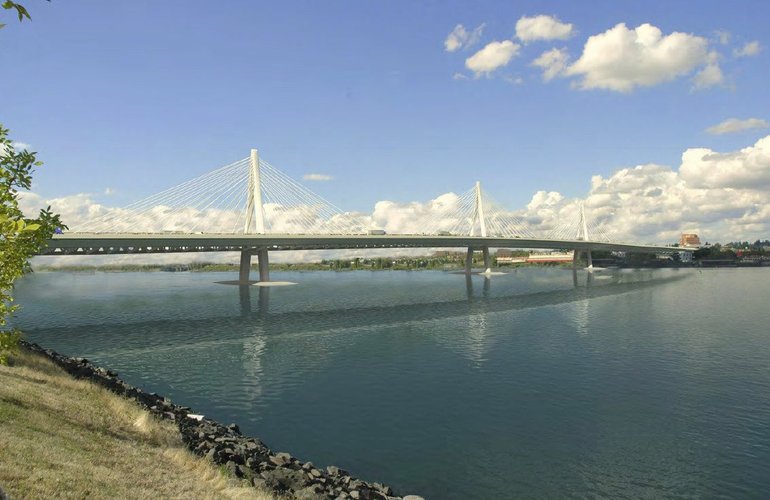The Columbia River Crossing project proposes to replace the existing twin three-lane drawbridges with 10 lanes over the river, improve five miles of Interstate 5 on both sides and extend Portland’s light-rail transit system into downtown Vancouver.
Go to http://columbian.com/i5bridge to see a project timeline, previous stories and other links.
As engineers finalize the design of a new Interstate 5 bridge across the Columbia River, the next big step will be coming up with the money to build it.
Planners have long anticipated a three-way split between the federal government, the two states and local revenue generated by bridge tolls to cover the $3.6 billion project, which also includes the extension of a light-rail line into Clark County as well as dozens of elevated ramps and overpasses on five miles of I-5 in Oregon and Washington.
Tolls? Check.
A big check from the federal government? No definitive word, but the prospects look good.
The states?
Imagine the sound of crickets chirping as Washington and Oregon lawmakers contemplate how their cash-strapped states can be expected to pony up $450 million each for the biggest public works project in the region’s history.
Washington lawmakers may look for private-sector help.
A House transportation bill includes $425,000 to evaluate the potential for using “innovative financing methods” on major highway projects. The new I-5 bridge is among four major state transportation projects — the others are in the Puget Sound region — that would be examined to see whether public-private partnerships make sense.
The state’s needs far outstrip its means.
“We thought a study would show us all the different ways you could structure financing on all these big projects, which are all mega-projects,” said Rep. Judy Clibborn, a Mercer Island Democrat who chairs the Transportation Committee.
Currently, road projects are funded by state and federal gas taxes. But the gas tax is declining as a source of revenue as vehicles become more fuel-efficient, people drive less and an increasing number of vehicles aren’t powered by petroleum at all.
The $425,000 study would explore the advantages, disadvantages and costs in each project of various forms of public-private partnerships.
Investing in tolls
“Most of them are, in some way, tolled facilities,” Clibborn said. In the simplest form, a private consortium would provide cash up-front — presumably by borrowing it — and then recoup the investment through tolling.
And that’s the problem, according to an influential CRC critic. Portland-based economist Joe Cortright authored an analysis last fall criticizing the I-5 project team for overly optimistic assumptions about project costs and revenue generated by tolls.
“Since the CRC is already counting heavily on tolls to pay more than a third of project costs, the only way you get more money is if the tolls are even higher than the rates already advertised,” Cortright emailed.
Motorists would pay a toll in the range of $2 to $6, under the scenarios currently being considered.
State law would have to be changed to accommodate a private consortium’s involvement in financing a new I-5 bridge, Clibborn said. That will require a “huge political process” that would have to be duplicated in Oregon, she added. Clibborn said the study, which would be completed this year, is merely a starting point for the discussion.
“It will give us very interesting and compelling information,” she said.
Tolls are a direct source of revenue.
However, because they are paid back over decades, toll-backed revenue bonds also include substantial finance-related costs. Cortright’s analysis, which is getting new attention in a memo signed by 20 Oregon state representatives this week, indicated that crossing planners expect to rack up $2.7 billion in interest costs over 30 years. Another $1.7 billion would be spent to operate the toll collection system, plus another $130 million in credit card fees.
Yet tolling is becoming increasingly accepted among lawmakers across the political spectrum, especially as the gas tax dries up.
Mileage tax? No
“There is no other choice,” Clibborn said. “The gas tax is not going to be the funding mechanism of the future, and we’re not ready to go to vehicle-miles traveled.”
State Rep. Ann Rivers, R-La Center, said tolling is a direct form of user fee that is commonplace across much of the country. Rivers, one of two Clark County members of the Transportation Committee, said she supports the idea of exploring a public-private partnership to fund the lion’s share of a new I-5 bridge.
Private enterprise can find efficiencies that state bureaucracies might not, she said.
It would also expect to be paid.
“Just like on the East Coast and Midwest, they would look at a tolling program,” Rivers said. “They would have to, as a users’ fee. But it’s quite possible they could do it at a much reduced rate.”
There is nothing wrong with leveraging private enterprise to create a public asset, said Paul Guppy, research director for the Washington Policy Center, a free-market think tank in Seattle.
“We don’t think there’s anything embarrassing about making a profit,” he said. “That’s how a private company knows they’re doing something effective.”
Yet the notion of a private company benefiting from an existing public thoroughfare rubs some people the wrong way. A plan to allow a private consortium to build the new Tacoma Narrows Bridge was shelved nine years ago in favor of a more traditional public finance plan, which also involves tolls.
Rep. Jim Moeller, a Vancouver Democrat who also serves on the Transportation Committee, said it makes sense to explore all possible sources of revenue before committing a half-billion dollars of state money.
“I’m as anxious as anybody else to get moving on this project, but I want to do it right,” he said.
Erik Robinson: 360-735-4551, or erik.robinson@columbian.com.



